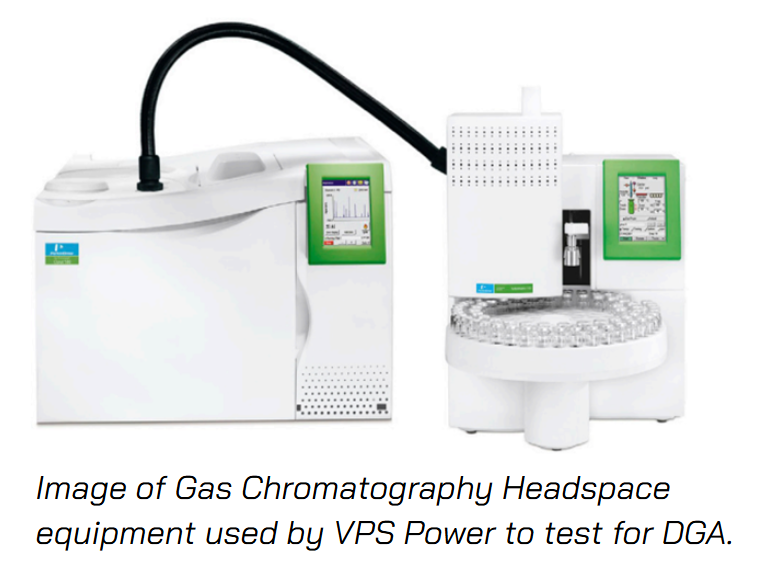The Importance of Dissolved Gas Analysis (DGA) in Transformer Monitoring
Introduction
Transformers are vital components in electrical power systems, and their reliability is crucial for uninterrupted power supply. Dissolved Gas Analysis (DGA) is a key diagnostic tool used to monitor the health of oil-filled transformers. By analysing the gases dissolved in the insulating oil, DGA provides valuable insights into the internal condition of transformers, helping to detect faults early and prevent costly failures.
Background of Dissolved Gas Analysis (DGA)
DGA involves the detection and quantification of gases produced within the transformer oil, due to various types of electrical and thermal faults. These gases include hydrogen (H₂), methane (CH₄), ethane (C₂H₆), ethylene (C₂H₄), acetylene (C₂H₂), carbon monoxide (CO), and carbon dioxide (CO₂). The presence and concentration of these gases can indicate specific types of faults, such as arcing, overheating, and insulation degradation.

Importance of DGA in Transformer Monitoring
1. Early Fault Detection:
DGA allows for the early detection of faults such as arcing, overheating, and insulation degradation. By identifying these issues before they lead to catastrophic failures, DGA helps in preventing transformer outages and extending the equipment’s lifespan.
2. Cost-Effective Maintenance:
DGA enables condition-based maintenance, allowing utilities to perform maintenance only when necessary, rather than on a fixed schedule. This approach reduces maintenance costs and minimizes downtime.
3. Improved Reliability and Safety:
Regular DGA testing improves the reliability and safety of transformers by ensuring potential issues are addressed before they lead to failures. This is especially important for transformers in critical infrastructure such as power plants and substations.
4. Compliance with Industry Standards:
DGA is a widely recognized method for transformer monitoring, and many industry standards, such as those set by the IEEE and IEC recommend regular DGA testing. Compliance with these standards ensures transformers operate within safe parameters.
Gas Types in DGA and Their Fault Indicators
1. Hydrogen (H₂):
- Fault Indicator: Partial discharges, low-energy arcing, and stray gassing.
- Explanation: Hydrogen is often the first gas to appear when there is a fault, indicating early-stage issues such as corona discharges or minor arcing.
2. Methane (CH₄):
- Fault Indicator: Low-energy discharges, low temperature thermal faulta, and stray gassing.
- Explanation: Methane can indicate thermal faults at lower temperatures, typically resulting from minor overheating of the oil or paper.
3. Ethane (C₂H₆):
- Fault Indicator: Medium-temperature thermal faults and stray gassing.
- Explanation: Ethane is produced at temperatures between 300°C and 700°C, indicating moderate overheating of the oil or paper.
4. Ethylene (C₂H₄):
- Fault Indicator: High-temperature thermal faults.
- Explanation: Ethylene is generated at temperatures above 700°C, suggesting severe overheating of the oil or paper, and potential insulation breakdown.
5. Acetylene (C₂H₂):
- Fault Indicator: Low energy and high-energy arcing in oil and paper.
- Explanation: Acetylene is a strong indicator of serious issues such as high-energy arcing, which can lead to significant damage.
6. Carbon Monoxide (CO) and Carbon Dioxide (CO₂):
- Fault Indicator: Insulation degradation and/or oil oxidation.
- Explanation: These gases are produced by the breakdown of cellulose insulation, and oil oxidation. High levels can indicate significant insulation deterioration.
7. Oxygen (O₂) and Nitrogen (N₂):
- Fault Indicator: Not produced by faults but indicate air ingress.
- Explanation: These gases are typically present due to the ingress of air into the transformer through leaks, and through contact with atmospheric air from the conservator of free breathing transformers.
Conclusion
Dissolved Gas Analysis is an indispensable tool for maintaining the health and reliability of oil-filled transformers. By leveraging DGA, you can ensure the longevity of your assets, reduce maintenance costs, and enhance the stability of the power grid.
For further advice and information, please contact: power@vpsveritas.com
 Search
Search
 Customer
Customer